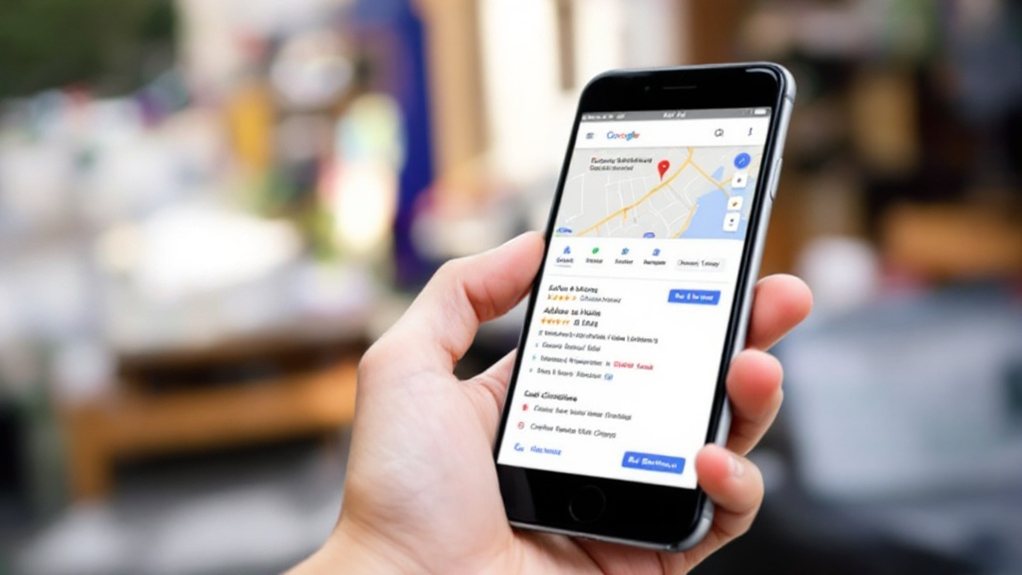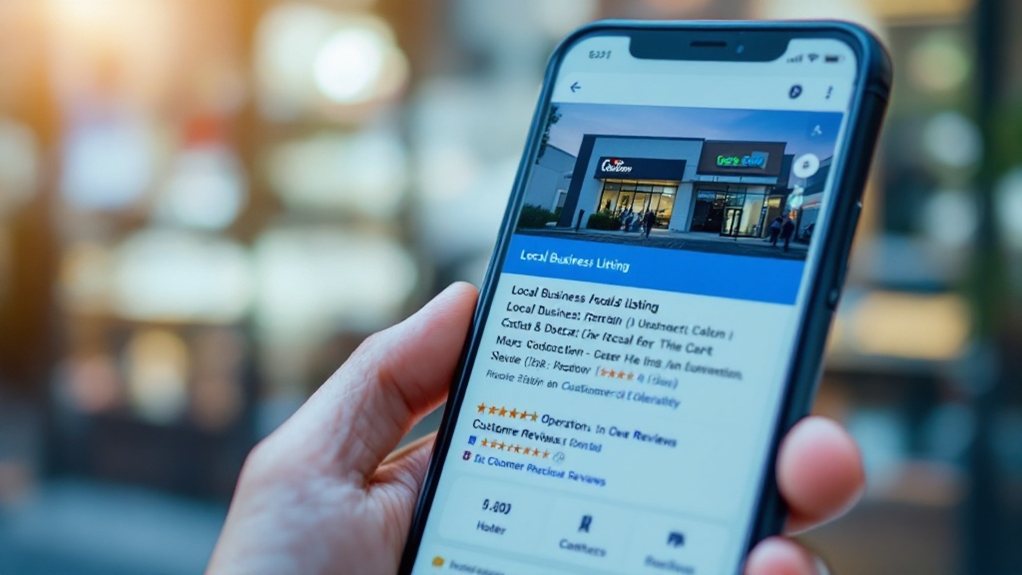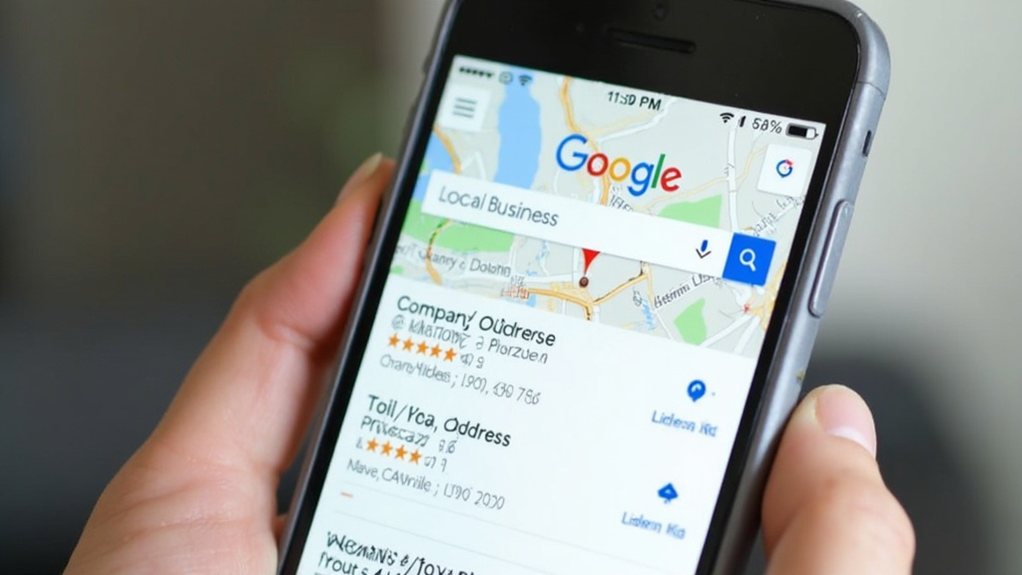To optimize your local listings for mobile users, ensure your Google My Business profile is up-to-date with accurate business details and mobile-friendly features. Enhance the user experience by implementing responsive design, fast page speeds, and structured data. Leverage "near me" searches by targeting location-specific keywords and providing comprehensive, mobile-optimized content. By focusing on the mobile user, you'll not only improve your search rankings but also entice more local customers to discover and engage with your business. Keep reading to dive deeper into advanced mobile optimization strategies.
Importance of Mobile Optimization for Local Listings

As mobile devices continue to dominate internet usage, optimizing your local business listings for mobile users has become paramount. A mobile-friendly listing ensures your key business details are easily accessible, boosting the user experience. This also improves your search engine rankings, as Google prioritizes mobile-friendly sites. With many mobile searches driven by immediate intent, a seamless mobile experience can lead to more visits and conversions. Additionally, well-optimized mobile listings give you a competitive edge, helping you outrank businesses without this optimization. Mobile searches often have immediate intent, such as finding a nearby business to visit. Ultimately, catering to mobile users' needs through your local listings can significantly impact your local SEO and overall business success.
Key Mobile Usage Trends Impacting Local Search

With smartphones becoming ubiquitous, you can't afford to overlook mobile usage trends impacting local search. Over 79% of mobile users search for local information, and voice searches account for 20% of mobile queries. Additionally, mobile searchers heavily rely on maps for business details. Ultimately, these behaviors lead to immediate purchases, with 76% happening the same day. 58% of consumers use voice search to get details on nearby businesses because it's convenient for those on the go.
| Trend | Impact |
|---|---|
| High Mobile Adoption | 58% of adults use smartphones daily |
| Rise in Voice Search | 20% of mobile queries |
| Growing Importance of Maps | Searchers rely on maps for business info |
| Immediate Purchases | 76% of local mobile searches result in same-day purchases |
Optimizing Google My Business Listings for Mobile Users

Optimizing your Google My Business (GMB) listing is crucial for reaching mobile users. Ensure your business name, address, and phone number (NAP) are consistent across all online platforms. Accurately categorize your business and include keyword-rich descriptions. Provide easy access to your website and social media profiles. Keep your hours of operation up-to-date, including holiday schedules. Upload high-quality photos and videos to showcase your business. Manage customer reviews promptly, respond to queries, and analyze feedback to improve service. Leverage advanced features like Google Posts, product listings, and local SEO integration. Stay compliant with Google's guidelines and adapt to new technologies to engage mobile users effectively.
Enhancing User Experience on Mobile Local Listings
Ensuring an optimal user experience on mobile local listings is crucial for engaging with your audience effectively. Implement responsive layouts, clean navigation, and easy-to-read content to create a seamless mobile experience. Optimize images, use touch-friendly interactions, and leverage local features like store locators and location-based content to enhance user engagement. Accurate and comprehensive local listings are also essential to ensure your business appears in relevant mobile search results.
| Mobile UX Enhancements | Benefits |
|---|---|
| Consistent Website Transition | Seamless user journey |
| Click-to-Call Buttons | Effortless communication |
| Interactive Maps | Improved navigation |
| Simple Contact Forms | Frictionless feedback |
| User Testing and Feedback | Continuous improvement |
Leveraging "Near Me" Searches to Attract Local Customers
The explosive growth of "near me" searches presents an incredible opportunity to attract local customers. Expertise in Local SEO Ensuring your local listings are optimized for mobile users and align with proximity-based search trends can significantly boost your visibility and drive in-store traffic. Take advantage of this powerful search behavior to connect with consumers seeking your products or services right in their neighborhood. Tailored solutions can help businesses leverage these local search trends to their advantage.
Capitalize on "Near Me" Trend
As consumer reliance on "near me" searches continues to grow, it's crucial for businesses with a physical presence to capitalize on this trend. Searches for shopping near me have grown over 200% in the past two years, validating the importance of local businesses with brick-and-mortar stores. Targeting location-specific keywords and optimizing your Google My Business profile can significantly boost your visibility in these high-intent searches. Prioritize mobile-friendly experiences, as most "near me" queries originate from smartphones. Closely monitor your reviews and ratings, as they directly impact your search rankings. By staying agile and adapting to evolving consumer behavior, you can effectively leverage the power of "near me" searches to attract local customers and drive conversions.
Optimize for Local Search Visibility
To effectively leverage the power of "near me" searches and attract local customers, you must optimize your online presence for local search visibility. Ensure your Google Business Profile is complete, with accurate details and engaging content. Strategically use relevant keywords, post updates regularly, and manage customer reviews to boost your prominence. Maintain consistent business information across all platforms to enhance your local authority. Ensure your website is mobile-friendly with fast page load speeds and intuitive navigation to provide a positive user experience for nearby customers. Additionally, enhance your website for mobile users by prioritizing speed, navigation, and local keyword integration. Leverage schema markup to provide structured data and increase the likelihood of appearing in rich snippets. By focusing on these optimization tactics, you can significantly improve your local search visibility and connect with nearby customers.
Leverage Proximity-Based Targeting
Proximity-based targeting is a powerful strategy that you can leverage to attract local customers and drive tangible results for your business. With over 900% increase in "near me" searches in the past two years, it's clear that consumers are actively seeking businesses in their vicinity. By leveraging Google's proximity bias and utilizing mobile location services, you can deliver personalized messages to users based on their geographic location. This not only enhances customer engagement but also drives instant conversions, as 50% of "near me" searches lead to store visits. Ensuring a mobile-friendly interface is critical given these searches are typically mobile. To maximize the impact, combine proximity targeting with strong local SEO and optimize your mobile interface for an integrated approach.
Managing Online Reviews to Boost Mobile User Trust
Maintaining a strong online review presence is crucial for boosting trust among mobile users. Responding promptly to both positive and negative feedback demonstrates your commitment to customer service. Consumers believe more physical effort required to write review on mobile, which endows the review with more credibility. Ensuring a consistent, positive reputation across all review platforms accessed by mobile users can further enhance their trust in your business.
Prominence of Review Presence
As a business owner, you can't afford to overlook the prominence of review presence when it comes to optimizing for mobile users. Over 99.9% of customers read reviews when shopping online, and 96% specifically look for negative reviews. Businesses should prioritize maintaining a positive online reputation. Reviews on social platforms can boost conversion rates up to 40 times on Facebook. Trust in reviews is paramount – 49% of consumers equate them with personal recommendations. With 91% of customers using reviews before purchasing, it's clear that reviews have become crucial to the buying journey. Leverage this insight to build credibility and drive conversions through your mobile-optimized local listings.
Responding Promptly to Feedback
Responding promptly to customer feedback is crucial for building trust and credibility with mobile users. 79% of negative reviewers expect a response, and 36% want it within a day. By addressing issues swiftly, you can prevent further negative reviews and retain customers. Offering solutions, showing empathy, and providing contact information demonstrate your commitment to customer satisfaction. Consistent, professional responses improve your reputation over time. Analyzing reviews also uncovers learning opportunities to enhance your products and services. Developing efficient communication templates can help you respond efficiently to negative feedback. Prioritizing prompt, thoughtful engagement with mobile users sets you apart from competitors and boosts your business's trustworthiness.
Consistent Reputation Across Platforms
Consistently managing your online reputation across platforms is crucial for building trust with mobile users. Ensure your social media profiles, review sites, and local listings all align in terms of branding and contact information. Inconsistent data can lead to mistrust and missed opportunities. Claim and verify all your profiles to boost credibility. Leverage review management tools to monitor and respond efficiently to customer feedback. Automating review requests can increase the volume, while integrating schema markup highlights positive reviews on your website. Showcasing stellar reviews acts as social proof to attract new mobile customers. Consistent, trustworthy online presence is key for thriving in the mobile landscape.
Implementing Responsive Design for Consistent Mobile UX
Implementing responsive design ensures your website provides a consistent mobile user experience across devices. With over 90% of websites now utilizing responsive design, you can boost your conversion rate by 11% and increase sales by up to 62%. Furthermore, responsive designs improve user engagement by 20%. To optimize your mobile UX, consider these key elements:
| Metric | Benchmark |
|---|---|
| Mobile-Friendly Preference | 72% of users prefer mobile-friendly navigation |
| Load Time Sensitivity | Users often leave if a page takes more than 3 seconds to load |
| User Retention | 74% of users are more likely to return to sites with good mobile UX |
| Conversion Rate Increase | Mobile-optimized sites see up to 40% higher conversion rates |
Responsive design is crucial for business credibility, local search visibility, and driving sales in the mobile-first era.
Improving Page Speed for Better Mobile Performance
Your mobile site's performance is crucial for engaging users. You can optimize page speed by managing resource loading, leveraging caching techniques, and reducing overall page weight. These strategies will ensure your local listings load quickly and provide a seamless mobile experience.
Importance of Page Speed
Since page speed significantly impacts user experience and SEO rankings, it's crucial to optimize your mobile pages for faster load times. A one-second delay can reduce conversions by up to 7%, while faster speeds lead to higher conversions and better search rankings. Optimized page speed also enhances user retention by reducing bounce rates. To improve mobile performance, address factors like unoptimized images, server delays, and inadequate caching.
| Factors Affecting Mobile Page Speed | Benefits of Faster Page Speed |
|---|---|
| Unoptimized images | Increased user satisfaction |
| Server delays | Reduced cart abandonment |
| Excessive scripts | More pageviews per session |
| Poor compression | Lower bounce and exit rates |
| Render-blocking scripts | Better ad performance |
Optimizing Resource Loading
Optimizing the loading of resources is crucial for enhancing mobile page speed and delivering a smooth user experience. Leverage modern image formats like WebP or AVIF to reduce file sizes by 30%. Implement lazy loading to conserve memory and bandwidth, and minimize HTTP requests by combining files. Compress data and minify code to further optimize performance. Asynchronously load non-critical content in the background to improve rendering and user engagement. Optimize API calls, utilize efficient data serialization, and cache network responses to streamline your network operations. Employ content delivery networks, server-side image processing, and strategic resource scheduling to maximize your resource optimization strategies.
Leveraging Caching Techniques
Leveraging browser caching can significantly speed up page loading times by storing frequent elements for quick retrieval during subsequent visits. Optimized caching enhances mobile performance by reducing repeated downloads and can positively influence SEO rankings. To further improve dynamic content caching, consider short-term microcaching, leveraging edge-side includes, and balancing freshness with speed.
| Caching Techniques | Benefits | Considerations |
|---|---|---|
| In-Memory Caching | Quick access to frequently used data | Requires specialized tools like Redis or Memcached |
| CDN Caching | Decreased latency and improved global accessibility | Ensuring content freshness and consistency |
| Object Caching | Reduced server load for API calls and database queries | Maintaining cache invalidation strategies |
| Microcaching | Temporary caching of dynamic content | Striking a balance between freshness and speed |
| ESI for Dynamic Content | Independent caching of webpage sections | Implementing the right architectural approach |
Utilizing Structured Data for Enhanced Mobile Visibility
Structured data is a powerful tool for enhancing your mobile visibility. By providing detailed business information in a machine-readable format, you can improve your search engine optimization (SEO) and attract more mobile traffic. Some key benefits of utilizing structured data include:
- Increased Visibility in Search Results: Structured data helps search engines display rich snippets, making your listing more appealing to mobile users and potentially boosting click-through rates.
- Optimization for Voice Search: Structured data is crucial for voice searches, enabling AI systems to deliver accurate and relevant information to mobile users.
- Competitive Advantage: Implementing structured data can differentiate your business from competitors, leading to better visibility and engagement on mobile devices.
Remember to use the JSON-LD format, select appropriate Schema.org categories, and regularly update your structured data to ensure consistency and accuracy.
Strategies for Mobile-Friendly Content Creation
When creating content for mobile users, it's crucial to tailor your approach to their unique consumption patterns and preferences. Keep headlines concise, use "chunking" techniques, and simplify language for clarity. Optimize visuals by compressing images and strategically placing them to enhance engagement. Implement responsive design, streamlined UI, and accelerated mobile pages for better usability and performance. Structure your content with short paragraphs, clear headings, and concise calls to action. Ensure text is readable, pages load quickly, and links are tap-friendly to deliver a seamless mobile experience. By focusing on these mobile-friendly strategies, you can effectively capture and retain your audience's attention.
